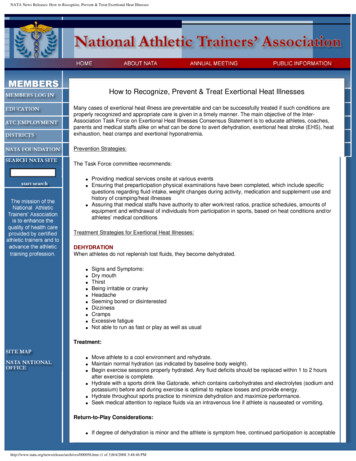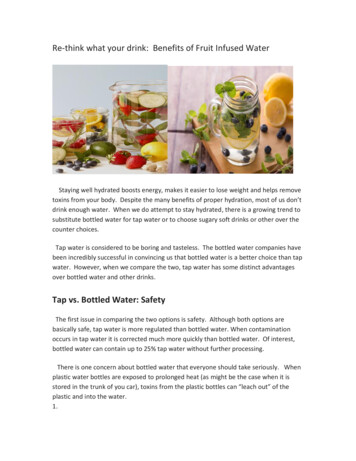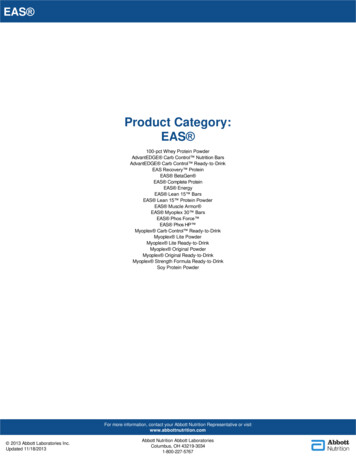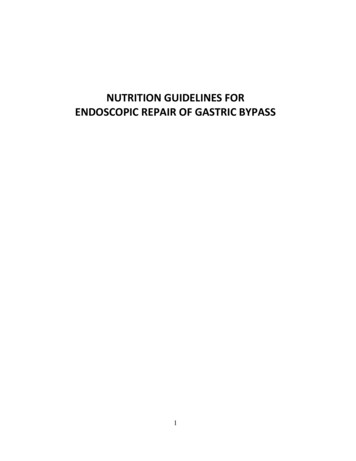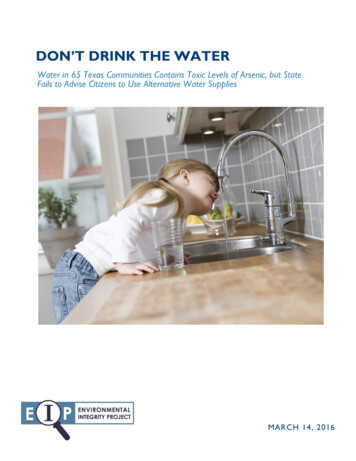
Transcription
DON’T DRINK THE WATERWater in 65 Texas Communities Contains Toxic Levels of Arsenic, but StateFails to Advise Citizens to Use Alternative Water SuppliesMARCH 14, 2016
ACKNOWLEDGEMENTSThis report was researched and written by CourtneyBernhardt, Abel Russ, Eric Schaeffer, Tom Pelton, andKira Burkhart of the Environmental Integrity Project.THE ENVIRONMENTAL IN TEGRITYPROJECTThe Environmental Integrity Project(http://www.environmentalintegrity.org) is anonpartisan, nonprofit organization established inMarch of 2002 by former EPA enforcement attorneysto advocate for effective enforcement of environmentallaws. EIP has three goals: 1) to provide objectiveanalyses of how the failure to enforce or implementenvironmental laws increases pollution and affectspublic health; 2) to hold federal and state agencies, aswell as individual corporations, accountable for failingto enforce or comply with environmental laws; and3) to help local communities obtain the protection ofenvironmental laws.For questions about this report, please contact EIPDirector of CommunicationsTom Pelton at (202) 888-2703 ortpelton@environmentalintegrity.org.PHOTO CREDITSCover and rear photos purchased from iStockphoto
Toxic Drinking Water in TexasThe federal Safe Drinking Water Act has required public water supplies to limit arsenicconcentrations in drinking water to no more than 10 parts per billion (ppb) since 2006, inorder to reduce exposure to the deadly toxin linked to lung and bladder cancers,neurological problems, and other illnesses. But the average arsenic concentrations in 65Texas community water systems serving more than 82,000 people has exceeded that healthbased standard over the last two years, according to data from the Texas Commission onEnvironmental Quality (TCEQ).1 About 51,000 of these people in 34 communities havebeen exposed to contaminated drinking water for at least a decade, many at levels severaltimes higher than the arsenic limit.For example, in Jim Hogg County in South Texas, more than 5,000 people have beenexposed to arsenic concentrations more than four times the limit in the Safe Drinking WaterAct for at least five years, state records show. In the City of Seagraves, in West Texas, 2,396residents have been exposed to water with arsenic more than triple the health standard formore than a decade. (See Table 1 for a list of the communities and their two-year and longterm average arsenic levels.)Despite the health risks, Texas fails to tell consumers to stop drinking the water and insteadimplies that it is safe. When local water utilities find violations, federal law requires localwater utilities to tell consumers that lifetime exposure to arsenic concentrations above 10ppb may increase cancer risk. But Texas also requires the advisories to state: “This is not anemergency You do not need to use an alternative water supply.”2 (For the full text of thelanguage Texas requires in drinking water notifications, see Appendix A).The drinking water disaster in Flint, Michigan, reminds us how important it is forgovernment to let the public know when to avoid drinking contaminated water. Federal lawrequires system operators to notify customers on a quarterly and annual basis when theirdrinking water violates standards for arsenic or other pollutants. But Texas is far from clearwith its residents.Whatever is intended, the Texas notices seem likely to lead some people to continuedrinking contaminated water. Telling consumers they don’t need to replace watercontaminated by arsenic suggests the water somehow remains safe to drink. While the lawrequires drinking water utilities to meet federal arsenic limits, it does not prohibit Texans oranyone else from drinking or cooking with water loaded with arsenic or other pollutants.But should the state suggest to its citizens that it is safe to do so?The advice from other states and public health experts is more straightforward, at least forprivate well owners. These states, including Wisconsin, Michigan, Maine, and Washington,tell people not to drink water with more than 10 ppb arsenic. For example, Wisconsinadvises private well owners: “If your arsenic level is more than 10 ppb, the WisconsinDepartment of Health Services recommends that you stop using your water for drinking orfood preparation.”3 Florida advises its consumers to avoid water where arseniccontamination persists.4 The U.S. Department of Health and Human Services makes1
similar recommendations.5 If anything, the most recent science suggests that the 10 ppbarsenic standard is not protective enough and that the IQ of children can be damaged atmuch lower exposures (see page 7).As this report explains, some of the affected water systems are being upgraded to removearsenic, while others may need financial assistance to complete such actions. In themeantime, consumers should be cautioned to avoid water that keeps flunking Safe DrinkingWater Act standards for this deadly carcinogen.It seems unlikely that state regulators who advise the public about health risk would let theirown families keep drinking water that violates the Safe Drinking Water Act limit for arsenicyear after year. If that is the case, then Texas health advisories should stop implying thatwater that keeps failing those standards is somehow safe to drink. This report alsorecommends: The U.S. Environmental Protection Agency (EPA) should revise its regulationsto require that states advise people to stop drinking or cooking with water thatfails to meet arsenic standards, at least when the contamination persists overseveral years. The advice should be sensitive to the additional risks posed whenchildren and other sensitive populations drink contaminated water. If there is noreason for consumers to take precautions, there is no reason for Safe DrinkingWater Act standards in the first place. Public notices should inform consumers of options for treating contaminatedwater at home, e.g., through filter systems that have proven to be effective.Conversely, the public should be told what doesn’t work. For example, whileTexas advisories warn that boiling water won’t reduce nitrate concentrations, itincludes no such warning for arsenic, which also cannot be boiled away. Federal and state governments should provide enough funding to these 65 Texascommunities to allow them to pay for the installation of water filtration systemsor take other steps to eliminate the contamination problem. Some work hasbegun to build water treatment systems, but more funds are needed.Informing consumers is an important strategy to protect public health. But information thatis confusing or misleading is toxic to public understanding and public trust, and underminesaction to make drinking water safe.2
Table 1. Average Arsenic Concentrations in 65 TexasCommunity Public Water SystemsWater System(In order of arsenic levels)Bruni Rural Water Supply Corp.*Jim Hogg County Water Control &Improvement Dist. 2Klondike Independent School Dist.Duval County CRD Benavides*City of Seagraves*City of Andrews*Country Villa Mobile Home ParkLoop Water Supply Corp.*Perry Water Supply Corp.TDCJ W Pack Unit*Prairie Hill Water Supply Corp.*Tri-County Special Utility District*City of New Home*Welch Water Supply Corp.*Pecan Grove Mobile Home Park*Boudreaux GardensLasalle Landing Water System*Grassland Water Supply Corp.*Hidden Tree RanchSpring Creek Pure Utilities*Victoria County Water Control &Improvement Dist. 2*City of KenedyAxtell Water Supply Corp.*Matagorda County Water Control &Improvement Dist. 2Cotton Bayou ParkTown North Estates*EOL Water Supply Corp.*Cyndie Park 2 Water Supply Corp.Valley Acres Mobile Home Park WaterSystem*Terrells Mobile Home Park*Duval County CRD ConcepcionGreen Acres Mobile Home ParkWolfforth PlaceCity of Wolfforth*City of Seminole*Country View Mobile Home ParkCity of RieselWebbJim 026/24/20033/9/2006ChambersLubbockMcLennanNuecesEl 04LubbockDuvalEl tart Date2/25/20022/25/20023
Water System(In order of arsenic levels)Ellinger Sewer and Water SupplyCorp.*City of Plains*Sawmill AdditionFreer WCIDLake Livingston Green AcresEl Paso Tornillo Water ImprovementDist.*Candelaria Water Supply Corp.*City of DanburyTown North Village Water System*Birome Water Supply Corp.R M S Water Supply Corp.Valley EstatesGardendale Mobile Home ParkCity of Opdyke West*Whorton Mobile Home Park*Refugio County Water Control &Improvement Dist. 1Village of Surfside Beach*Tempe Water Supply Corp. 1M S Water Supply Corp.*Twin Oaks Mobile Home Park*Redford Water SupplyCity of Liverpool*Jim Wells County Fresh Water SupplyDist. 1Sherwood Estates Mfg. TownhomeCox Addition Water System*Iwanda Mobile Home ParkCity of MortonHackberry Creek ckEctorHockleyLubbockRefugio842,3253351,523(see McLennanMidlandPresidioBrazoriaJim akumOrangeDuvalPolkEl PasoPop.ServedSamplingStart Date5/14/2003Notes: Systems marked with * have consistently exceeded 10 ppb for at least a decade (2005-2016), based onannual averages and available data. The communities are listed in order of their 2014-2015 arsenic concentrations.See the attached spreadsheet for annual averages and a sortable version of this table. “Long-term” averages referto the average since the sampling start date. Some data gaps exist due to infrequent sampling. R M S Water SupplyCorp. does not directly serve a community. Rather, it sells water to the City of Riesel and M S Water SupplyCorp. Click on the name of system to visit Texas Drinking Water Watch.4
Texas Communities with Tainted WaterThe 65 Texas water systems with excessive levels of arsenic are mostly in small towns orrural areas clustered in West Texas and near the Gulf Coast. (See Map 1, below). Some ofthese systems serve mobile home parks that house low-income residents. Together, these 65public systems with arsenic-tainted water serve more than 82,000 people.6 About 51,000residents in 34 communities have been exposed to contaminated drinking water for at least adecade, many at levels several times higher than the arsenic limit. (Table 1). At least 30,000of these residents were likely exposed to concentrations of arsenic at levels at least twice thefederal standard in 2014 and 2015, according to state data.7 (Table 2).Table 2. Summary of Texas Water Systems Supplying WaterContaining Over 10 ppb ArsenicAverage Concentration Range(2014-2015)Greater than 50 ppb30-50 ppb20-30 ppb10-20 ppbTotalNumber of Community 151,34882,206These communities rely on groundwater, and the arsenic in their water often comes fromnatural sources underground, according to TCEQ. Arsenic is a chemical element andcarcinogen that exists in some rocks and dirt, and it has been used in a variety of industrialproducts, including pesticides, paint, and wood preservatives.8 It is also a well-knownpoison at high doses. According to EPA, arsenic can build up inside iron pipes and storagetanks and then be released in dangerous amounts when there is a change in flow rates orwater chemistry. 9 This can be hard to detect, however, because there are no federalrequirements for monitoring water quality within distribution systems. 10The highest average arsenic levels in Texas were in Bruni, Texas, about 42 miles east ofLaredo. There, the Bruni Rural Water Supply Corporation has supplied 648 people withwater containing arsenic at levels nearly eight times the federal standard over the past twoyears, according to state data.11Because many smaller water systems test for arsenic less than once every three years, someconsumers have no way of knowing when they might be drinking toxic water. Texasregulations require systems that use groundwater to sample for arsenic every three years. Ifresults show levels in excess of the legal limit, they have to sample quarterly until levels areconsistently below the federal standard of 10 ppb.12 But not all systems comply with theserequirements. For example, in West Texas, Deys RV and Mobile Park in Andrews Countylast tested for arsenic in 2013 and detected concentrations of 12.3 ppb. The system has notsampled for arsenic since, according to data available from the state, but appears to be activeand supplying water to 296 people.5
Map 1. Average Arsenic Concentrations in Community PublicWater Supplies, 2014-2015Residents who rely on private water wells in the same areas may also be exposed to arsenicin their drinking water. Map 2 (below) shows domestic and irrigation groundwater wellsthat have detected dissolved arsenic concentrations over 10 pbb since 1985, according tosampling data from the Texas Water Development Board.13 Private wells, unlike publicwater systems, are not protected by the federal Safe Drinking Water Act.6
Map 2. Dissolved arsenic detected in private domestic andirrigation water supply wells at levels over 10 ppb 14The Health Effects of ArsenicArsenic is known to cause cancers of the lung, kidney, bladder, skin, and other organs; andany level of exposure carries some risk.15 According to EPA, the risk of developing cancerafter drinking water containing 10 ppb arsenic over a lifetime is 1 in 2,000.16 This level ofrisk is almost never ‘acceptable’ from a regulatory perspective. The agency usually tries tolimit lifetime cancer risk to no more than 1 in 10,000, at most. EPA’s risk estimate assumesthat the cancer risk is linear, meaning if water contains 20 ppb arsenic, those who drink itover a long period of time have a 1 in 1,000 chance of developing cancer. People exposed7
over shorter periods of time have lower risks, but exposure during childhood may have agreater impact than exposure during adulthood.17And those risk calculations reflected the old thinking. New evidence suggests that the cancerrisk may be much higher. EPA is currently revising its assessment of cancer risks fromarsenic to incorporate more recent science. A 2010 draft of the assessment indicated that therisk of getting cancer from drinking water containing 10 ppb of arsenic is closer to 1 in 136,more than 17 times higher than current assumptions.18In adition to causing cancer, arsenic is also a neurotoxin that can harm developing brains atlevels at or below the allowable limit.19 One recent study in Maine, for example, foundsignificant reductions in IQ and other problems in children exposed to arsenicconcentrations of 5 to 10 ppb.20 Specifically, children in homes with more than 5 ppbarsenic in the tap water tested roughly 6 points lower on a full-scale IQ test.21 What is clearis that the ‘safe’ level or arsenic is much lower than 10 ppb, and anything above 10 is clearlyunsafe.The history of EPA’s arsenic rule reflects the continuing evolution of scientific knowledgeabout the harms that even low levels of the element can cause. Back in 1996, Congressamended the Safe Drinking Water Act and directed EPA to establish new limits for arsenicto replace the old standard of 50 ppb.22 Based on the best available research, EPA proposeda limit of 5 ppb in 2000. The agency then revised its proposal, based in part on costconsiderations, and finalized a new arsenic standard of 10 ppb in 2001. The EPAAdministrator at the time, Christine Todd Whitman, explained that "the 10 ppb protectspublic health based on the best available science and ensures that the cost of the standard isachievable."23 The new regulations required that public water systems across the U.S. meetthe new standard by January 23, 2006.24 The law allowed states to grant exemptions untilJanuary 23, 2015, for some small community water systems that had trouble complying.25Public Notices Fail to Protect Public HealthMore than a decade after EPA and Texas were supposed to start enforcing the new arsenicstandard, and despite the health problems that arsenic can cause, public awareness of therisks associated with arsenic remains murky. Public water systems are required to complywith public notice and reporting requirements established by the Safe Drinking Water Actand Texas regulations. These requirements exist to ensure that consumers know what is intheir water and if they should take precautions. Unfortunately, the citizens of Texasroutinely receive mixed messages in these notices, if they receive them at all.Each year, community water systems are required to publish and distribute to customers aConsumer Confidence Report that summarizes water sampling results from the previousyear, highlights any violations, and lists what is being done to correct the problem. The SafeDrinking Water Act also requires community water supplies to issue public notices whenwater quality tests reveal that water has arsenic over 10 ppb.8
Sometimes community water suppliers fail to inform consumers that their water iscontaminated. For example, some residents of a mobile home community on the GulfCoast, Cindy Park in Nueces County, Texas, were unaware of the arsenic in their water forseveral years, until they found out in 2011.26 Water from this community system exceeded10 ppb arsenic for at least 6 years before this date, according to sampling results from theTCEQ. Other systems, like those serving Lubbuck County’s Whorton Mobile Home Park,Hidden Tree Ranch, and Pecan Grove Mobile Home Park; the City of Andrews, in westTexas; and the community of Bruni, east of Laredo, have been issued violations related topublic notice and reporting over the past two years, according to TCEQ’s online records.27In addition to annual reports that document drinking water quality, water systems arerequired to issue and post public notices when water has arsenic over 10 ppb, generally on aquarterly basis. Both EPA and TCEQ require local utilities or communities to include thefollowing statement about the risks posed by arsenic: “Some people who drink watercontaining arsenic in excess of the MCL (10 parts per billion) over many years couldexperience skin damage or problems with their circulatory system, and may have anincreased risk of getting cancer.”28 This statement fails to advise consumers about risks tosensitive populations, such as children, who are more susceptible to the impacts of arsenicexposure. For the sake of contrast, here is how the state of Michigan explains the risksassociated with arsenic:The way arsenic affects our bodies is not fully understood. Long-term exposure to lowlevels of inorganic arsenic in drinking water is known to cause human health problemsincluding: cancer, thickening and discoloration of the skin, problems with blood vessels,high blood pressure, heart disease, nerve effects including numbness and/or pain, andinterference with some important cell functions. Short-term exposure to very high levelsof arsenic may cause stomach pain, nausea, vomiting, diarrhea, headaches, weakness,and even death; but, groundwater in Michigan has not been shown to have this high alevel of arsenic. There is some evidence that suggests that long-term exposure to lowlevels ( 0.005 milligrams/liter (mg/L)) of arsenic from drinking water may result inlower IQ scores in children. 29Is Water Contaminated with Arsenic Safe to Drink?Regardless of how specific risks are explained, consumers most want to know whether it issafe to keep using water that is contaminated with arsenic. The EPA allows states to decidewhether or not to advise residents to find alternative sources of drinking water when thelocal water supply violates the limit in the Safe Drinking Water Act. In contrast to otherstates, Texas requires public notices from water systems to include the phrases “this is notan emergency,” and “you do not need to use an alternative water supply.”30 Perhaps thatlanguage makes sense when an arsenic violation is rare and does not recur. But it should beunacceptable for systems that have violated the health-based standard for arsenic for a longperiod of time. After years of drinking water that contains over 10 ppb of arsenic, consumersshould be advised to use another water supply due to the long-term risks of exposure to thetoxin, especially when children may be exposed.9
Other states and public health experts are more straightforward with their advice aboutdrinking water containing over 10 ppb of arsenic, at least for private well owners. Privatewell water is not regulated under the Safe Drinking Water Act,31 unlike water in publicdrinking water systems. Regardless of the source of drinking water—a private well or apublic supply—the health risks associated with arsenic are the same. Table 3 higlights someof the language used by other states and the U.S. Department of Health and HumanServices.Table 3. Advice to Private Well Owners About Arsenicin Drinking WaterAgencyU.S. Department of Healthand Human Services(ATSDR)Michigan Department ofEnvironmental QualityFlorida Department ofHealthWisconsin Department ofNatural Resources &Department of HealthServicesWashington StateDepartment of HealthMaine Department of Healthand Human ServicesAdvice to private well owners“Residents should install a treatment system that effectivelyremoves arsenic, find an alternative source of drinking water, oruse bottled water for drinking and cooking if their home drinkingwater comes from wells in which the arsenic level exceeds 10 µg/L(ppb).”32“If the arsenic in your water exceeds 0.010 mg/L (10 ppb), the DEQrecommends that you do not use your well water for drinking orcooking.”33“Levels of arsenic less than the drinking water standard are notlikely to cause illness. Drinking water with levels slightly above thestandard for a short time period does not significantly increase therisk of illness. However, because health risks increase as the levelsof a chemical (or how long a person drinks it) increases, it is best todrink water that meets standards.”34“If your arsenic level is more than 10 ppb, the WisconsinDepartment of Health Services recommends that you stop usingyour water for drinking or food preparation.”35“We recommend that water used for drinking or food preparationcontain no more than 10 ppb arsenic. While reducing arsenic below10 ppb can lower your chance of developing health effects, it is notlow enough to completely eliminate that risk. If your water containsbetween 10 ppb and 50 ppb arsenic, your chance of developinghealth problems increases. We recommend you not drink watercontaining these levels or use it for food preparaƟon over the longterm. In either case, you will need to balance the health risks, costs,and convenience when deciding whether or not to conƟnue to useyour water supply. If your water contains more than 50 ppbarsenic, we recommend you stop using it immediately for drinkingand food preparaton.”36“If your result is between 10 and 50 ug/L (ppb) or 0.01 and 0.05mg/L Don't drink your water or use it to make drinks like coffee, tea,juice, or infant formula. You can use your water to cook and other uses.If your result is above 50 ug/L (ppb) or 0.05 mg/L10
AgencyMinnesota Department ofHealthAdvice to private well owners Don't drink your water or use it to make drinks like coffee, tea,juice, or infant formula. Don't use your water to make soups and stews, or to cook driedfoods such as rice, beans, oatmeal and pasta. These foods absorb alot of water during cooking. You can use your water for other uses such as brushing teeth,bathing, washing dishes, and watering the garden In most cases, you can protect yourself if you stop drinking waterwith too much arsenic in it.”37“Based on the MCL for public water systems, the MinnesotaDepartment of Health (MDH) recommends that water containingmore than 10 micrograms per liter of arsenic (10 ppb) not beconsumed over the long term.”38Removing Arsenic from Drinking WaterIn Texas, plans to modify public water treatment systems must be approved by the TCEQ.Sometimes the first option for small water systems is to dilute contaminated water byblending it with uncontaminated water, assuming a cleaner water supply is available. Watersystems can also build treatment systems to remove arsenic. These systems can employ arange of technologies including filtration and precipitation, adsorption media like ferricoxide and activated alumina, ion exchange, and reverse osmosis.39 Some methods toremove arsenic can also effectively remove other contaminants, like iron and dissolvedsolids. Treatment is not guaranteed to reduce arsenic to levels below 10 ppb, and costs mustbe considered, especially for small community water systems with limited financialresources.In-home water treatment is another alternative, and is often recommended for people whorely on private groundwater wells. Public water supplies can also provide these treatmentsystems to individual homes instead of, or in addition to, system-wide treatment. Some inhome treatment options include iron oxide filter systems, reverse osmosis, and anionexchange.40 Each of these can be scaled to treat all water entering a home or at specificpoints within a home. However, people relying solely on in-home treatment systems shouldget their tap water tested to ensure that the systems are reducing arsenic and othercontaminants to safe levels. Residents should also be careful to use only the treated waterfor drinking and cooking. Boiling water will not remove arsenic.Many small community water systems have taken or are currently taking steps to clean uptheir water and protect consumers. Some have gone as far as closing down and evictinglong-time tenants of properties with contaminated water, as the Greenwood Mobile HomePark in Midland County did in 2014.41 The City of Andrews, near Odessa in West Texas,received a 380,000 grant from EPA in 2012 to build a new water filtration plant, and cityofficials said the project was finally completed in December 2015.42 The City of Smyer inWest Texas provides treated water to citizens from a tap at City Hall, according to itswebsite.43 Some towns, like the City of Opdyke West, also in West Texas, and Birome,11
south of Dallas, have received funding to construct treatment systems from the Texas WaterDevelopment Board, which offers money for improving water supplies.Building filtration or alternative water supply systems can be difficult because governmentfunding is often scarce and hard to secure in Texas and elsewhere. Many of thesecommunities in Texas with contaminated water are in remote locations, and connecting tocleaner water supplies maintained by larger cities or counties can be expensive.Conclusion and RecommendationsThe water contamination crisis in Flint, Michigan, threw a national spotlight on problemswith drinking water systems that extend far beyond one state and that are more profoundthan just pipes. A central failure in Flint was that the state government had informationabout contamination of drinking water, but did not warn the public. In Texas, the pollutantof greatest concern in the 65 communites discussed in this report is different – arsenic,instead of lead -- and the source of the problem is different. In Texas, the arsenic isnaturally occurring; while in Michigan, the catastrophe was man-made, with the state andcity trying to save money by switching to a source of water, the Flint River, that corrodedthe plumbing, releasing high levels of lead from pipes and solder.But in both Michigan and Texas, the state governments compounded the watercontamination problems – and allowed people’s exposure to damaging toxins to continue -by not communicating clearly with consumers.Deciding how best to explain health risks to the public is admittedly a challenging task. Butthere is enough evidence to reach the following conclusions:1) Texas should update the language in its public notices so consumers clearly knowwhen to safeguard their health by avoiding contaminated drinking water. Citizensshould be told to find alternative drinking water sources, especially when childrenmay be exposed and when arsenic contamination has persisted for a long period oftime.2) EPA is currently conducting a new review of arsenic toxicity, and it should concludethat work and revise its mandatory language for public notice of arsenic violations.This mandatory language should include a statement about the potential health risksof childhood exposure.3) Public notices should inform consumers of options for treating contaminated waterat home, e.g., through filter systems that have proven to be effective. Conversely, thepublic should be told what doesn’t work. For
Valley Acres Mobile Home Park Water System* El Paso 54 13.8 22.6 8/5/2004 Terrells Mobile Home Park* Lubbock 70 13.7 15.3 2/23/2004 Duval County CRD Concepcion Duval 161 13.5 10.6 2/2/2004 Green Acres Mobile Home Park El Paso 141 13.4 13.6 3/23/2004 Wolfforth Place Lubbock 460 13.4 15.3 5/22/2003 City of Wolfforth* City of Seminole*


